WORLD CLASS COACHING
Tactical Series
Antonio Conte
By Jonny Carter and Michael J. Louter
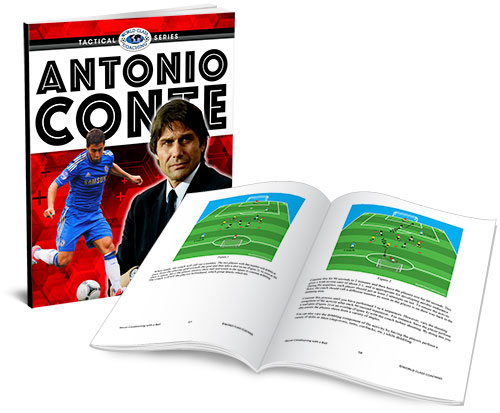
Part Two
TRADITIONS AND CONVENTIONS OF THE 3-4-3 - DEFENSIVE PHILOSOPHY
THE SHAPE OF PLAY
THE SHAPE OF PLAY - DEFENSE
Traditions & Conventions of the 3-4-3 | Defensive Philosophy
The way the 2016/17 version of Chelsea FC defends opposition build-up play in the 3-4-3 is also somewhat different from tradition and is a very modern way to defend as a team. The front three in the 3-4-3 allows for high pressure very early in the phase as the opposition attempt to build possession out of the back. When defending against an opposition goal kick or early build-up phase Chelsea FC can cover the full width of the field with their front three and press early on an opponent attempting to play out of the back or better still, causing the opposition to abandon their tactics all together and playing out longer.
However, these pressing tactics were not so aggressive in traditional examples of the 3-4-3 deployment, instead many proponents of the 3-4-3 choosing to defend a little more cautiously.
In the example, the defending team in Black can spread their front three across the width of the field. The Yellow team has the option to attempt to play out of the back from the goal kick through the #2 Right Fullback.
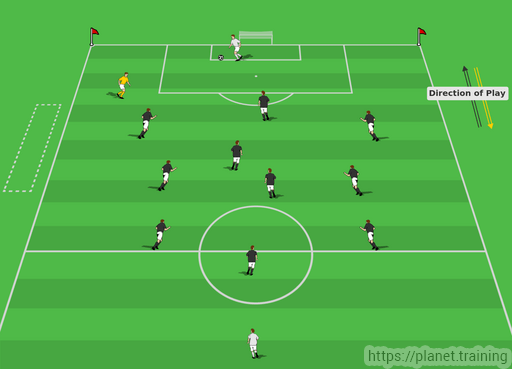
As the ball is played into the Yellow #2 Right Fullback the entire Black team begins to adjust their positioning based on the ball-side position of the Yellow player in position, the 1st Attacker.
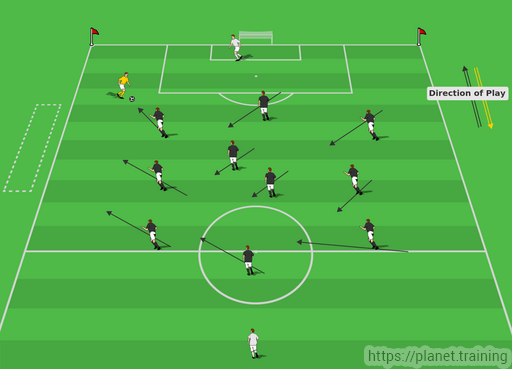
The nearest goal-side player applies immediate pressure to stop the ball being played forward. In this example it is the #11 Left Forward who assumes the role of the 1st Defender, ‘deny the penetration’.
The #9 Center Forward and the weak-side #7 Right Forward drop and slide over to the ball-side providing cover and balance to the 1st Defender.
Below this front line pressure the midfield compact and condense the space behind as the ball-side players slide and push up behind the front line pressure while the weak-side players drop and slide over to the ball-side providing defensive support behind the play, denying space for the opposition and screening passes forward and searching for counter attack opportunities on the transition.
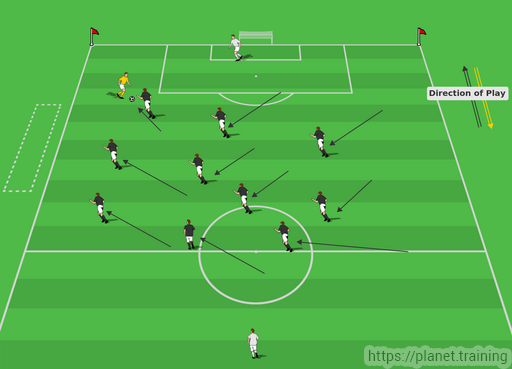
Below this midfield line the three man defensive group responds similarly by compacting and condensing the space behind the midfield as they slide over to the ball-side providing defensive support behind the play. The three defenders now looking more like a conventional four man defensive group with a ball-side fullback supported with two central defenders providing cover and balance behind.
Of course, unlike with a four man defensive group, the right fullback berth is not assigned, this role provided by the weak-side midfielder dropping in and attaching himself to the weak-side defensive responsibility as necessary.
The early pressing tactics and the condensed distances of the defending team mean that large numbers of players are compact into a small area of the field leaving the opportunity for longer more direct balls to be played into the vacant space left behind the defensive group. The role of the goalkeeper is even more evident at this moment of the structure as his high starting position and aggressive attitude as sweeper-keeper allows him to patrol this vacant area in-behind ready to eliminate danger.
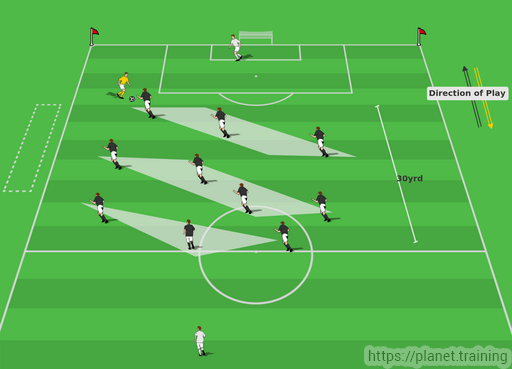
This defensive setup sees three very evident lines of Pressure > Cover > Balance overloaded onto the ball-side of the field with the groups compact and condensed behind. Even the goalkeeper’s starting position is relevant in this defensive organization and requires excellent coordination and full team commitment in order to be successful.
But as earlier referenced, this is a rather outdated deployment of this defensive strategy. Even though this is a very assertive and proactive way to defend with the early press, the way that Chelsea FC tends to do things is with an even more aggressive attitude to their pressing tactics.
Given the same example of the Yellow team looking to build-up play out of the back from the goal kick into the #2 Right Fullback, there are some subtle changes.
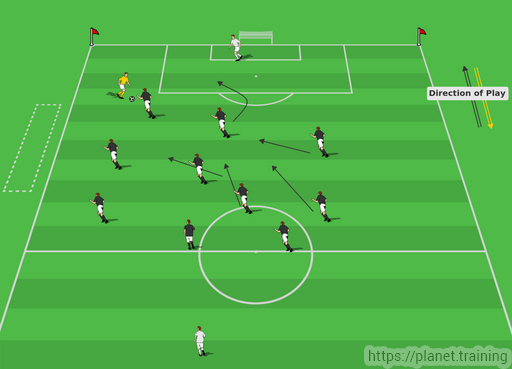
The pressure on the ball is required, and the compacting and condensing of the field is required, and the high starting position of the goalkeeper sweeper-keeper is all very evident. But instead of just dropping into three Pressure > Cover > Balance lines as traditionally seen, Chelsea FC tend to look to cut off more angles of support and go hunting for the ball with large groups of players in a very, very hostile manner.
This more aggressive attitude to pressing tactics means that the front three have a very focused defensive responsibility, they are not asked to work large areas of the field or to take on a large defensive role. The space in which the front three work defensively and the opposition players that they are assigned to defend against is clear and limited.
The area of the field in which the front three are asked to press also provides great incentive. If the ball is won back early and high on the field then the potential success for an immediate counter attack, direct to goal, is massively increased.
These refined defensive responsibilities, secured by the defensive structure behind, has revived the fortunes for an ailing front three for Chelsea FC since reverting to the 3-4-3 formation. Eden Hazard went from player of the season to hapless nobody overnight. Diego Costa travelled a similar journey falling from the Premier League’s best #9 Center Forward to a grumpy yellow card addict. Both players have rediscovered their imperious best form through the 2016/17 season and these revivals have corresponded, not coincidentally, with a change in Chelsea FC formation to a 3-4-3 system of play.
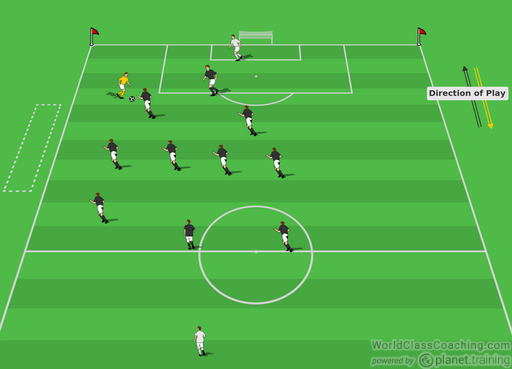
To demonstrate an excellent in-the-game example of Chelsea FC’s pressing tactics within their 3-4-3 system of play we have an example taken from their recent Premier League game versus Stoke City FC played at Chelsea FC’s home stadium Stamford Bridge on Saturday 31st December 2016; a game Chelsea won 4 – 2.
Here we can see Stoke City FC in possession of the ball. There is an equal number of Stoke City FC players and Chelsea FC players involved in the immediate play. Most Chelsea FC players are in a defensive position goal-side of the play.
The body language of the Chelsea FC players suggests that they are moving forward as a collective to apply pressure to the ball rather than retreat to a more passive defensive shape.
The 1st Defender is applying excellent pressure to the ball.

Here we can see Chelsea FC players applying pressure not just from a goal-side position but from all angles onto the ball.
Eden Hazard, the #11 Left Forward of the Chelsea FC front three is blocking any potential angles of support and blocking any potential passing lanes backwards to supporting Stoke City FC players or to the goalkeeper.
Willian, the #7 Right Forward of the Chelsea FC front three has come all the way over from the weak-side of the field to join the press.

Here we can now see more Chelsea FC players than Stoke City FC players, not just more players in the vicinity, but more Chelsea FC players aggressively pressing the ball. Four Chelsea FC players surround the 1st Attacker denying passing angles in every direction, with a second wave of Chelsea FC players compacting and condensing the space.

There is less of a visible structure to theses pressing tactics, we do not see anything like the organization of the Pressure > Cover > Balance lines referenced earlier. The success of these pressing tactics is built more on pure aggression towards the ball and mass invasion of the space.
Diego Costa the #9 Center Forward is also involved in the press from an offensive position; he too is blocking any escape angles of support and aggressively pressuring the 1st Attacker.
All three of the Chelsea FC forward group are involved in the press, two players from an offensive position. All of them are within 10 – 12yrds of each other and all on the same ball-side of the field.
Here we can see the amount of pressure and the sheer numbers of Chelsea FC players has created a moment of transition and forced a turnover.
We can see by the field markings how high up the field the transition has occurred and how positive the Chelsea FC players are to counter attack quickly to the Stoke City FC goal in search of a reward for their hard work pressing the ball.

The Stoke City FC players are unbalanced and out of defensive shape due to the speed of the counter attack, they struggle to reclaim their defensive principles. Stoke City FC are under massive pressure again, only this time, Chelsea FC have the ball 25yrds from their goal.
Here we can see from the wider angle how exposed the Stoke City FC defenders are. We can also see how close to the Stoke City FC goal that the turnover of possession is; and how quickly Chelsea FC can add numbers and width to their counter attack.
Within a handful of touches and within two quick passes Chelsea FC have created a 2-v-1 situation on top of the Stoke City FC penalty area; the outcome inevitable.

Here we see Willian in-behind the Stoke City FC defensive line with an immediate and direct counter attack; the exposed goalkeeper has little chance.
Willian scores to make it 3 - 2; Chelsea FC go on further to win this game 4 – 2.

The 3-4-3 formation allows a large number of players to play in advanced areas of the field; in this example we can see perfectly how the front three of Chelsea FC have been super aggressive in their field positioning and in their attitude to press the ball. The risks are high if an opposition can break the press and play out, but the rewards are evident if executed correctly.
This high pressure defending often displayed by Chelsea FC also suits the playing profile of their players. Skillful and busy players don’t want to track backwards and don’t want to have large defensive responsibilities; which was definitely a feature of past coaching regimes at Chelsea FC. However, if these same skillful and busy players are only asked to defend in small amounts early in the opposition build-up, with security of help behind, then they can cope with that arrangement. And in the case of Eden Hazard, these players can flourish defensively with the incentive of goal threatening counter attacks as a reward.
The Shape Of The Play
The Chelsea FC 3-4-3 system of play has an overall shape to their play that is very expansive and very positive. The four man midfield group set up much differently from the narrow midfield diamond that we discussed with the FC Barcelona style of the mid 1990’s; rather the 2016/17 Chelsea FC set up with a midfield four spread the entire width of the field. The wide midfielders, usually Marcos Alonso the #8 Left Midfielder and Victor Moses the #6 Right Midfielder; playing on the touchlines more like conventional wingers.
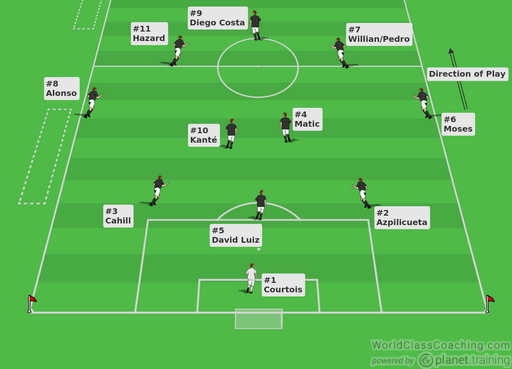
This width in midfield allows the defensive group behind to stay narrower and more compact without the fear of fullbacks being caught up field which might be the case in a conventional four man defensive group.
The additional benefit to the width being in the midfield is that the forward three can play very connected together. Yes, the front three can spread the width of the field when desired, but most of the time Chelsea FC keep the front three of Eden Hazard #11 Left Forward, Diego Costa #9 Center Forward and either Willian or more recently Pedro as the #7 Right Forward very much connected.
The starting positions of this 3-4-3 system of play make for very natural angles of support and passing lanes in multiple directions with balanced coverage across the field.
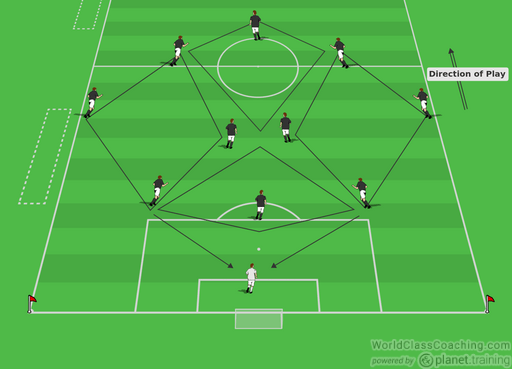
Taken at the kickoff, from Chelsea FC’s recent Premier League home game against Hull City FC played Sunday 22nd January 2017; we can see the clear 3-4-3 shape with the wide midfielders hugging the touchlines.
We can also see the mindset of Hull City FC’s strategic response to the 3-4-3 of Chelsea FC. Already Chelsea FC have imposed their strategic will over the perceived inferior opposition.


The Shape Of The Play | Defense
The tree man defensive group has a number of benefits. The added security of covering players in the vital central areas of the field in front of goal provides the team with security and a platform to be able to attack with confidence.
Most Premier League opposition teams playing against Chelsea FC will only play with one designated forward and then a combination of supporting forwards or attacking midfield lines behind. This lack of numbers in opposition to Chelsea FC’s three man defensive group permits them to be able to play out of the back in the comfort of numerical supremacy and stage attacking phases of play relatively untroubled as seen below.

This build-up play from the back can be patient and intricate; at other times it can be extremely direct and equally devastating. One of the vital components of a three man defensive group is that, at minimum, one of the three is required to be a cultured passer of the ball, as comfortable in possession as any midfielder, even under the duress of the precarious field position close to goal.
When Conte was head coach at Juventus FC and later the Italy national team where he played with a three man defensive group, he was blessed with one such typical cultured #5 Central Defender. Leonardo Bonucci was that fulcrum of the three man defensive group who was able to dictate the tempo, build-up the attacking phases of play and hit those elegant longer passes direct to the front.
In the Johan Cruyff 3-4-3 FC Barcelona team of the 1990’s there too we could see the classic example of a cultured ball playing #5 Central Defender; Ronald Koeman. Dutch international Koeman played near 200 games for FC Barcelona, winning countless trophies and scoring a disproportionate number of goals given his field position; even a European Cup winning goal. Koeman’s cultured passing from the back set the platform for the FC Barcelona dominance with the 3-4-3 system of play.
Chelsea FC’s Premier League domestic rivals and fellow proponents of the 3-4-3 Tottenham Hotspur FC also have a world-class ball-playing #5 Central Defender, Belgium international Toby Alderweireld. Tottenham Hotspur FC’s recent defeat of Chelsea FC while mirroring their 3-4-3 formation was no accident and much of the Spurs success can be attributed to the range of passing from Alderweireld.
Conte is all too aware of the need for a Chelsea FC player with this type of playing profile.
Chelsea FC have one such player, David Luiz. Another 2016 summer signing, Luiz is making his return to Chelsea FC from Paris Saint-Germain FC. Luiz’s first spell at Chelsea FC was a mixed affair, with relentless question marks posed about his natural defending capabilities. A relentless question not answered by a mindboggling display as captain of the Brazil national team during the 1 – 7 Fifa World Cup semifinal defeat in 2014. However, on return to Chelsea FC, and under a different system of play, Luiz is thriving; a genuine world-class ball-playing #5 Central Defender.
As we see from the images below, the combination of low pressure on the Chelsea FC early possession and build-up play, combined with the talented range of passing from David Luiz in the #5 Central Defender role, creates is a very positive attacking alchemy.
David Luiz goes from back to front in a very direct manner, very direct but also very accurate. Under little or no pressure, Luiz is able to look up and spot the positive movement from the front three in very threatening areas of the field. Luiz picks up possession on the edge of his own 18yrd box, approximately 80 - 90yrds from the opposition goal and with all eleven opponents defending goal-side.
The elevated pass is very straight but also very accurate into the path of the outside-to-inside movement of #7 Right Forward, Pedro (shirt number #11). The lofted ball bypasses the entire opposition team and travels to the edge of the opposition 18yrd box with pinpoint precision.
Pedro is able to collect the amazing pass, organize the controlling touch quickly and create a goal scoring opportunity with 80 yards of territory covered in two seconds.



David Luiz is also a world-class #5 Central Defender on the transition; the changeover of possession. Luiz is confident enough in his talents to be able to bring the ball out of the moment of transition and quickly build a counter attack. Most robust defenders are happy to just clear their danger zone when halting and opposition attack. Chelsea FC with David Luiz as their #5 Central Defender recognize this moment of transition as an opportunity to counter. This attacking philosophy combined with technical execution to match is daunting to defend against as an opposition.
Below we can see David Luiz and teammates Create > Recognize > Execute a moment of transition. The positive changeover of possession to Chelsea FC is the catalyst for a Luiz-inspired counter attack.

Luiz carries the ball out of the defensive zone and confidently into the midfield. With his eyes up and constantly looking for penetrating movement ahead the ball Luiz is able to initiate a rapid counter attack. The front three of Chelsea FC are certainly willing runners anticipating a quality through ball from a pass-master.

The change to widescreen angle of the next screenshot shows the vision of Luiz to pick out the generous attacking movement of the Chelsea FC forward line.

Through the recognition and speed of the counter attack Luiz has already broken multiple opposition lines on the dribble, rendering those potential recovery runners as obsolete. The awareness to identify the forward movement is sensational. The quality of the penetrating pass, perhaps 40 or 50yrds with pinpoint precision, is also sensational, and similarly, breaks yet more opposition defensive lines.

Within seconds Michy Batshuayi who is running the #9 Center Forward channel is in on goal with only the keeper to beat. A devastating counter attack that requires great composure and the complementary skill set to make happen.




